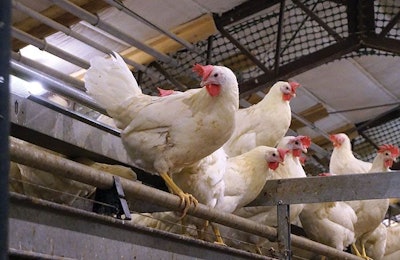
Most poultry welfare schemes have primarily relied on resource-based measures like inches of perch space per layer, maximum number of pounds of broiler allowed per square foot of floor space, or the number of square inches allocated per hen in either a cage or cage-free environment.
Dr. Joy Mench, chairperson of the United Egg Producers' (UEP) scientific advisory committee, said resource-based measures have some advantages because they tend to be easy to measure and translate into legal requirements.
Mench told the audience at the United Egg Producers Executive Conference that resource-based welfare measures are sometimes derived from research study results, but not always. Even if the welfare standards reflect research results, resource-based measures reflect results with specific breeds of birds at a moment in time. The results might not be the same with a different breed or even with the same breed a few years later as selective breeding changes that line of birds.
Simply put, she said resource-based measures are inflexible and do not always improve animal welfare.
Outcome-based welfare standards
Mench said space allocated per bird in poultry houses is a good example of how resource-based measures don’t always ensure improved welfare. She said Dr. Marian Dawkins conducted research on commercial broiler farms in the U.K. looking at the effect of space on outcome-based measures like foot pad condition and lameness.
"What she found was that space was not a terribly important factor in causing these problems. What really was important was litter management and ventilation and air quality," said Mench. "What was more important was how good the producers were in managing their flocks."
"This work led the EU to change their ideas of how they would set space requirements. Now, producers are allowed to have relatively high stocking densities, as long as they don't have foot problems and lameness. If you have lameness issues, they you have to reduce stocking density until you can resolve the problem," she said.
Outcome-based welfare measures attempt to quantify the impact of the bird’s environment and the management of the poultry house on the bird. Examples of outcome-based measures are morbidity and mortality, body condition, feather cover, injury and air quality. Sometimes outcome-based measures are referred to as animal-based measures.
Outcome-based welfare measures have several advantages: they apply across all housing systems, are flexible, allow for continuous improvement, can benefit hen welfare and economics for the producers, and they have high acceptability.
Mench said that the United Egg producers will be moving to outcome-based standards for its UEP-Certified program.
The World Organization for Animal Health (OIE) has developed broiler welfare standards and is in the process of developing welfare standards for laying hens. OIE welfare standards are focused primarily on outcome based welfare measures.
Measuring bird outcomes
Mench cited feather loss for laying hens as a good outcome based welfare measure. Feather loss occurs in all housing systems, examination of the hens can provide insight into the reason for the feather loss, whether it is from feather pecking, aggression or rubbing against the enclosure. Feather loss can also lead to a more serious problem, cannibalism. Feather loss is recognized as both a welfare and production issue. A production issue because poorly feathered are less well insulated and have to eat more feed to maintain their body temperature.
Focusing on the welfare outcome without mandating how it is arrived at provides the flexibility for innovation and the opportunity for continuous improvement. This is particularly important when trying to improve performance on welfare measures that have multiple possible causes like feather and vent pecking.
Mench said that the ultimate goal of any welfare system should be to improve bird welfare over time. Making outcome based measurements allows the producer to know where they are today and give them the opportunity to make changes that will lead to improvements in the future. These measures can then be used to bench mark the results of one operation versus the rest of the industry.
Auditor training is crucial
With outcome-based welfare measure, the auditors/accessors need to be well-trained. The outcome-based standards need to be validated and practical to measure. With meat birds, Mench pointed out that many of the bird measurements can actually be taken at the slaughter plant. Things like foot pads scores, breast blisters and bruising and broken bones can all be evaluated on the shackle lines. In fact, some companies already participate in grade improvement programs where many of the measurements are already being taken each flock and are bench marked against other participating operations.
The negatives of outcome-based measures are that that can be time consuming to make, the birds may have to be handled to be evaluated and the evaluators have to be well trained.
Mench said that auditing or evaluating for some outcome-based welfare schemes can take several hours per house to accomplish. She said that the AssureWel scheme only uses seven measurements for laying hens – feather loss, bird dirtiness, beak trimming, antagonistic behaviors, flightiness, birds needing further care and mortality. She said that this evaluation can be completed in around 15 minutes per house and doesn’t require the assessor to handle any of the birds.
The AssureWel scheme for broiler welfare is a little more complicated than for layers and consists of four parts, the whole flock assessment, defined walk, individual measures and on-farm record.
AssureWel is a collaborative project of the RSPCA, the University of Bristol and the Soil Association.
Future poultry welfare standards
Mench said that any outcome-based measures selected for use in a welfare scheme need to have an importance to welfare, can be easily and accurately measured and be things that producers can actually do something about through changes in management. She said that some resource based measurements might still be included in future welfare standards.
Mench suggested that for layers perch space per hen based on the size of the hens might be one resource-based welfare standard that is included along with outcome-based standards in the future. She said that she also expects that some behavioral measures will also be included. Mench said that the retailers she has had contact with are interested in outcome based measures.
The opportunity for continuous improvement is one of the key benefits of outcome-based welfare measures. Mench said that producers will need to set benchmarks, either regional or national ones to compete against. She also said that outcome-based welfare measures will fail if critical limits are not established.


















